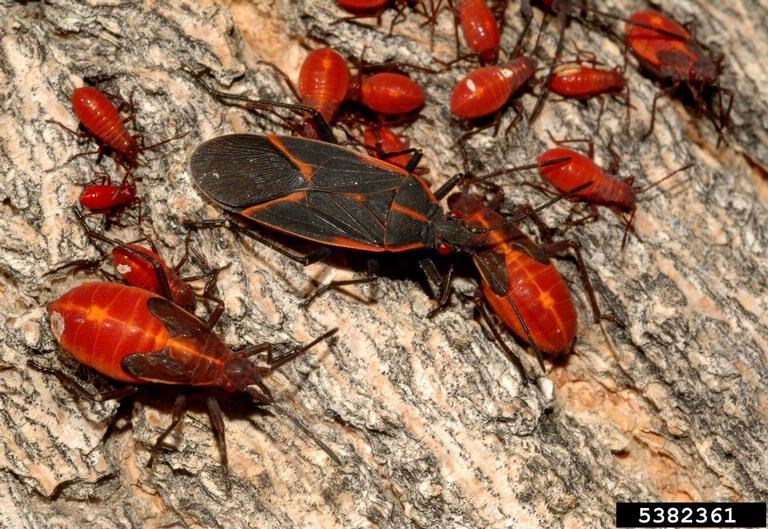
Boxelder bugs: those little black and red insects that seem to appear out of nowhere, especially around autumn. You might have seen them congregating on sunny walls, squeezing through window cracks, or even taking a dip in your pet’s water bowl. But what are they, and should you be worried about them?
This comprehensive guide dives deep into the world of boxelder bugs, exploring their behavior, potential impact on your home and garden, and most importantly, how to manage them effectively.
Understanding Boxelder Bugs: More Than Meets the Eye
While their striking red and black coloration might seem alarming, boxelder bugs are generally considered harmless. They are closely related to cicadas and aphids, feeding primarily on the seeds of boxelder trees (hence their name), as well as maple and ash trees.
Here’s a closer look at their characteristics:
- Appearance: Flat, elongated-oval body with distinctive black and red-orange markings.
- Size: About half an inch long, slightly smaller than a dime.
- Lifecycle: They go through simple metamorphosis (egg, nymph, adult), with adults overwintering in warm, sheltered places.
- Diet: Primarily feed on the seeds of boxelder, maple, and ash trees.

Debunking the Myths: Are Boxelder Bugs Dangerous?
Let’s address the elephant in the room: Are boxelder bugs dangerous to people, pets, or property?
The short answer is: Not really.
Here’s a more detailed breakdown:
To People:
- Biting: While they are capable of pricking the skin if handled roughly, boxelder bugs are not known to bite. Even if they do, the sensation is minimal and comparable to a pinprick.
- Disease Transmission: Boxelder bugs are not known to carry or transmit any diseases to humans.
- Odor: They do release a pungent, unpleasant odor when crushed, often mistaken for stink bugs.
To Pets:
- Toxicity: Boxelder bugs are not poisonous or venomous to pets.
- Taste Aversion: Their taste is quite unpleasant to most animals, and pets that eat them might experience vomiting or digestive upset. However, this is usually a one-time occurrence as they quickly learn to avoid them.
To Property:
- Structural Damage: Unlike termites or carpenter ants, boxelder bugs do not cause structural damage to homes.
- Staining: Their excrement can leave unsightly stains on light-colored surfaces, fabrics, and clothing.
- Odor: Large infestations can create an unpleasant odor, especially in confined spaces.

Managing Boxelder Bugs: Effective Prevention and Control Strategies
While boxelder bugs are more of a nuisance than a threat, their presence in large numbers can be bothersome. Here are some effective strategies to prevent them from entering your home and manage existing infestations:
Prevention is Key:
- Seal Entry Points: Carefully inspect your home’s exterior for cracks, gaps, and crevices around windows, doors, vents, and utility lines. Seal these entry points with caulk, weather stripping, or expanding foam.
- Install Door Sweeps: Door sweeps create a barrier at the bottom of doors, preventing insects from crawling underneath.
- Window Screens: Ensure all windows, especially those facing south or west, have properly fitted screens.
- Remove Attractants: Boxelder bugs are attracted to warmth and sunlight. Keep firewood piles, leaves, and other debris away from your home’s foundation.
Control Measures:
- Vacuuming: Regularly vacuum up any boxelder bugs you find inside your home, especially around windows and doors. Dispose of the vacuum bag promptly to prevent odor.
- Soapy Water: A simple solution of soapy water can be effective in killing boxelder bugs. Mix a few tablespoons of dish soap in a spray bottle with water and spray directly on the insects.
- Diatomaceous Earth: This natural powder is made from the fossilized remains of diatoms and works by dehydrating insects. Sprinkle diatomaceous earth around entry points and in areas where you see boxelder bug activity.
- Professional Pest Control: For severe infestations, consider contacting a reputable pest control professional. They can assess the situation and recommend the most appropriate treatment plan.
:strip_icc()/close-up-box-elder-bug-67726eeab1184924b281e2b86568a436.jpg)
Resources for Further Information:
- National Pest Management Association (NPMA): https://www.pestworld.org/
- University of California Statewide Integrated Pest Management Program (UC IPM): https://www.ipm.ucanr.edu/
- Environmental Protection Agency (EPA): https://www.epa.gov/
By understanding the nature of boxelder bugs and implementing effective prevention and control strategies, you can coexist peacefully with these fascinating creatures without sacrificing the comfort and enjoyment of your home and garden.








